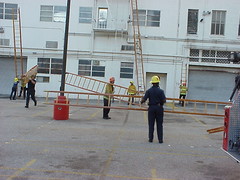An interesting paradox is seen in two surveys reported by Madbury, N.H.-based NFI Research.
According to Chuck Martin, NFI CEO, fully 87% of 2000 senior executives and managers surveyed responded that the top characteristic they look for in new hires is "willingness to learn." (Only half of the respondents went on to say that most of their current executives, managers and employees were willing to learn, however. )
Interestingly, two thirds of respondents to a subsequent NFI survey complained that employees are not actively participating in learning opportunities that are provided to them. "Although the level of learning provided is high in many organizations, the number of individuals taking advantage of these opportunities is lacking," Martin notes.
So... executives desire a trained workforce. The training is available. But in many cases, employees are not getting that training. Where is the disconnect?
According to Rebecca Hefter, Senior Vice President for Training at Boston-based Novations Group Inc., time is an important barrier to getting training done. Corporate trainers are under increasing pressure to limit the time employees spend off the job. "The trend is toward reduced classroom hours, more training done on-the-job and greater reliance on e-learning."
E-learning, however, can be its own "tough sell" in many organizations. Pull people off the job for a classroom session, and there they are in the classroom – a captive audience. But make training available "anytime, anywhere" via online means? Many busy learners will avail themselves of the training "sometime, somewhere" – but probably not here and now, given their overloaded schedules.
Perhaps one of the most important solutions to this problem lies in internal marketing of crucial training programs. The research that goes into an internal marketing plan is the topic for a whole other article, but at the core of the effort is the communication that is critical to getting the word out.
GET THE WORD OUT!
At GCPLearning, we have years of experience with clients who purchase our content and then need help to get their e-learning program going. We've created a 33-page workbook we call Maximize your E-Learning Investment with Change Management that spells out in detail the 10 well-documented critical steps you can implement quickly to maximize effectiveness and eliminate the costly mistakes so many organizations make in launching e-learning. We sell this workbook for $299, but I'm making it available to you, faithful readers, through the end of the year - click HERE to download it for free.
One of the key topics in the workbook is planning for communication to get your e-learning program off the ground. Here, briefly, are some of the key techniques for effective communication to get that training done, not sometime, somewhere, but here and now:
E-mail announcing the e-learning initiative – A clear and concise message showing management’s support and expectations for e-learners
Brochures, posters, payroll inserts, and articles in the company newsletter – Don’t rely exclusively on electronic communication to communicate your training themes and priorities. Also, market both the subject matter and the change in medium to e-learning.
Scrolling message on your learning center homepage – This brief message should be updated periodically.
Publicize new and revised courses – Let people know whenever your library is updated.
Develop a training calendar - Consider developing a training calendar, for example, “January is Safe Driving Month.” This is one of the best ways to maintain the momentum once your e-learning initiative has gotten off the ground.
Buddy system – Peer support is a leading factor in the success of e-learning programs. Buddies can be assigned or self-selected. The buddy system gives e-learners someone to turn to if they encounter uncertainty while becoming accustomed to e-learning. Buddies also encourage and remind each other to complete their training on schedule.
Attend departmental meetings – Speaking at departmental meetings provides an opportunity to obtain valuable feedback, clear up any misconceptions, and recruit new e-learners.
Form a training advisory committee – By assembling an advisory committee, you’ll establish credibility, show that you value the input of all stakeholder groups, and gain perspective on future needs and trends.
Contests – When multiple groups or facilities are involved in your e-learning program, a little friendly competition might spice things up. For example, a competition could focus on course completion rates.
Find new, appealing ways to reward those who complete training on time – By rewarding users for the completion of training, you are reinforcing the value of training and providing motivation to continue.
Keep communication 2-way – Publicize the excitement and accomplishments of your e-learning (e.g., higher-than-expected enrollments, outstanding course evaluations, and student and management testimonials). But also be sure to provide opportunities for your learners to discuss both the pluses and minuses of the program. By having a voice, your employees will feel a vested ownership in the training program and will be more likely to participate actively and even enthusiastically.





